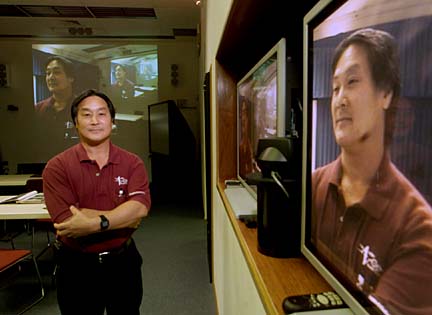


|
With the help of satellite telecommunications and other secure communication systems, Adm. Walter Doran can bring his staff together at the Makalapa Pacific Fleet briefing room and talk. Tech center links military
An isle business wires a Makalapa
site with teleconferencing toolsBy Gregg K. Kakesako
gkakesako@starbulletin.comHe can see any of his commands throughout the Pacific and as far away as the Persian Gulf even if they are on warships at sea.
The $2.7-million facility designed and built by a local business -- the Audio Visual Company -- is just one of about 100 that the Waimalu firm has installed for the military and private businesses in Hawaii.
Thomas Lee, who assumed control of the company in 1988, now heads a staff of more than 33. The company is expected to earn more than $10 million this year.
The Makalapa facility is equipped with the latest video communications and video display technologies, said Lee, "to provide an integrated approach to the management of voice, video and data into one seamless information processing and display system to aid in command decision making."
This is done by displaying all of the information using five rear projection monitors, each measuring 50 inches in diameter. Combined, this means these 15 monitors can project images on a screen that is 20 feet wide and 8 feet high, Lee said.
"The purpose of combining all these monitors is to create one virtual screen," Lee added, "which is essentially one video wall."
Connected to that "video wall" are 40 computers, video cassette recorders, DVD players, 30 microphones and a series of 17 speakers.
Doran and his staff sit around an U-shaped table facing the "video wall," Lee explained. "At each of these 17 station positions is a keyboard, a mouse and a small monitor. There are connections so if someone wants to bring in a laptop and use it during a briefing, he can easily connect it to the master system."
When the system is used to make video conference calls, Doran has the ability to connect to 15 sites anywhere in the world.
"As a person enters the conversation," Lee added, "his voice activates the situation and his picture pops up on the video wall."
Lt. Jeff Danzinger, spokesman for the Pacific Fleet, notes that "although the U.S. Pacific Fleet's headquarters is here in Hawaii, our forces operate from the West Coast of the United States to the Arabian Gulf, encompassing 102 million square miles and more than 190 ships and submarines, 1,400 aircraft, 191,000 sailors and Marines and 30,000 civilians."
The Makalapa briefing room is currently used to present classified and unclassified presentations and briefings to military and civilian leaders, covering everything from homeland defense to theater-wide, command-level decision-making.
Danzinger said: "In the past we had to bring commanders to Hawaii for conferences, but the fleet briefing room allows us to have teleconferences with numerous commanders on short notice. It also allows for face-to-face meetings via classified video conferencing with his (Doran's) forward deployed commanders and other command centers ... "
Lee said the system was the brainchild of Adm. Archie Clemens while he was commanding the Pacific Fleet several years ago and went through several modifications before his company built it more than three years ago. It became operational in August 2001.
The Makalapa briefing room is just one of 100 "command and control centers," as Lee describes them, which his company has designed and installed both for the military as well as for the private sector.
"A similar command center was put into place four years ago for the commander in chief of the Pacific at Camp Smith," Lee said.
He has done similar telecommunications systems at Pearl Harbor, the Mabel Smythe conference center and Queen's Medical Center conference room, and the executive board rooms at St. Francis Hospital and First Hawaiian Bank.
His video display systems have been installed at St. Ann's Church in Kaneohe, Kaimuki Christian Church, Loco Motion in Waikiki, Pearlridge Center and Shinnyo-en Temple.
Lee, 48, graduated from St. Louis School in 1972 and immediately joined the Hawaii Air National Guard to learn electronics, spending six years working as an electronic and communications technician. In 1978, he joined a local television repair service and later became a partner in the company until he bought the Audio Visual Co.
One of his first projects six years ago was developing First Hawaiian Bank's videoconferencing system in the bank's 30th-floor downtown board room.
"They had hired GTE to develop such a system," Lee said. "However, the company was only able to set up a video conference line, but it wasn't able to integrate video, data and other systems. GTE couldn't give them (First Hawaiian) what it really wanted.
"I think that what separates us from other companies. We're local. We will tackle any problem and come up with a solution. We can provide round-the-clock service."